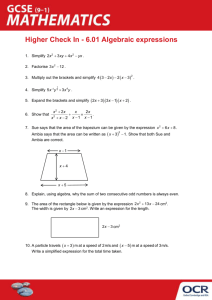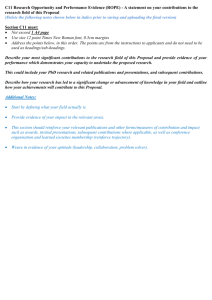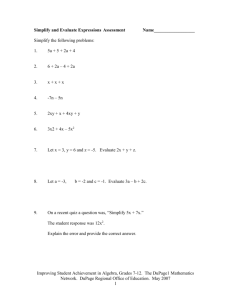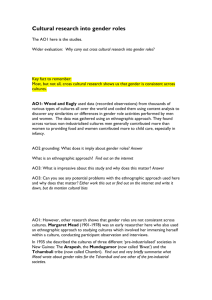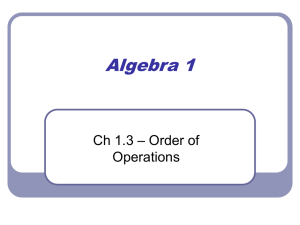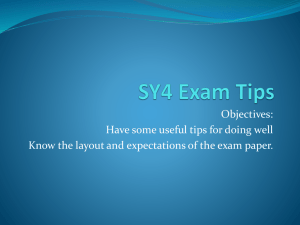Foundation Topic Check In 6.01 - Algebraic expressions
advertisement
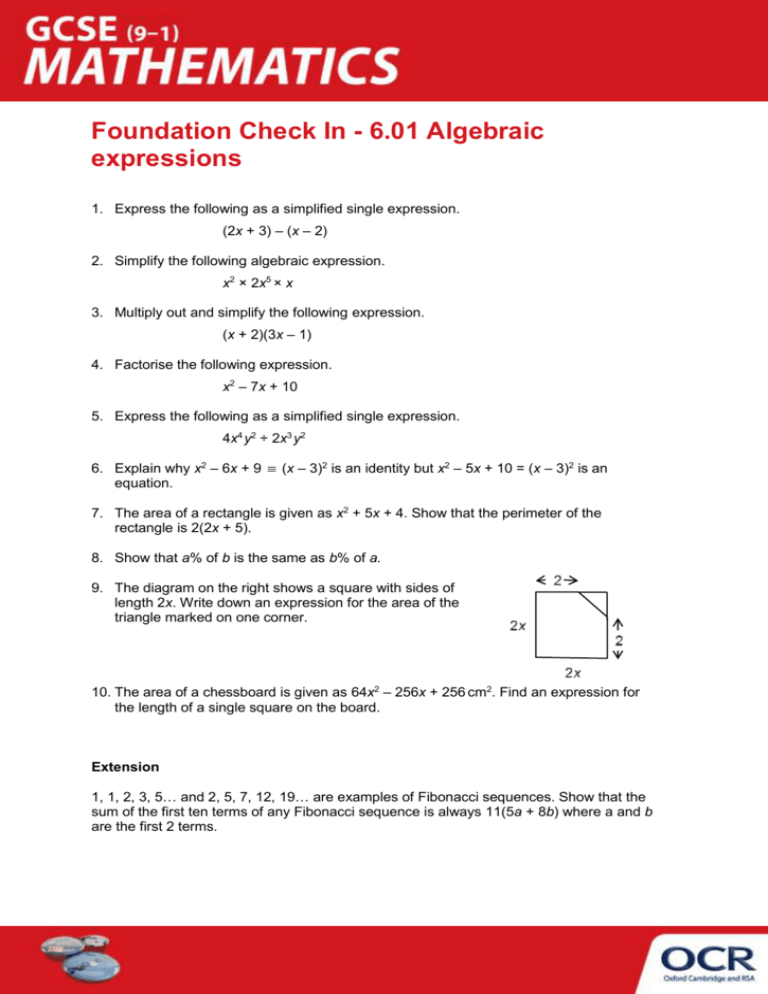
Foundation Check In - 6.01 Algebraic expressions 1. Express the following as a simplified single expression. (2x + 3) – (x – 2) 2. Simplify the following algebraic expression. x2 × 2x5 × x 3. Multiply out and simplify the following expression. (x + 2)(3x – 1) 4. Factorise the following expression. x2 – 7x + 10 5. Express the following as a simplified single expression. 4x4 y2 ÷ 2x3 y2 6. Explain why x2 – 6x + 9 (x – 3)2 is an identity but x2 – 5x + 10 = (x – 3)2 is an equation. 7. The area of a rectangle is given as x2 + 5x + 4. Show that the perimeter of the rectangle is 2(2x + 5). 8. Show that a% of b is the same as b% of a. 9. The diagram on the right shows a square with sides of length 2x. Write down an expression for the area of the triangle marked on one corner. 10. The area of a chessboard is given as 64x2 – 256x + 256 cm2. Find an expression for the length of a single square on the board. Extension 1, 1, 2, 3, 5… and 2, 5, 7, 12, 19… are examples of Fibonacci sequences. Show that the sum of the first ten terms of any Fibonacci sequence is always 11(5a + 8b) where a and b are the first 2 terms. Answers 1. x + 5 2. 2x8 3. 3x2 + 5x – 2 4. (x – 2)(x – 5) 5. 2x 6. x2 – 6x + 9 (x – 3)2 is an identity because it is true for all values of x, but x2 – 5x + 10 = (x – 3)2 is an equation because it is only true when x = -1. 7. x2 + 5x + 4 = (x + 4)(x + 1) so the length is x + 4 and the width is x + 1, giving a perimeter of 4x + 10 = 2(2x + 5). 8. a ab b b a 100 100 100 9. Area = 1 (2x – 2)(2x – 2) = 2x2 – 4x + 2 2 10. Factorising by the number of squares gives 64(x2 – 4x + 4), then factorising again to find the length of the side of each square gives x2 – 4x + 4 = (x – 2)(x – 2). Side length is x – 2 cm. Extension a, b, a + b, a + 2b, 2a + 3b, 3a + 5b, 5a + 8b, 8a + 13b, 13a + 21b, 21a + 34b. Sum of the first ten terms is 55a + 88b = 11(5a + 8b). We’d like to know your view on the resources we produce. By clicking on ‘Like’ or ‘Dislike’ you can help us to ensure that our resources work for you. When the email template pops up please add additional comments if you wish and then just click ‘Send’. Thank you. If you do not currently offer this OCR qualification but would like to do so, please complete the Expression of Interest Form which can be found here: www.ocr.org.uk/expression-of-interest OCR Resources: the small print OCR’s resources are provided to support the teaching of OCR specifications, but in no way constitute an endorsed teaching method that is required by the Board, and the decision to use them lies with the individual teacher. Whilst every effort is made to ensure the accuracy of the content, OCR cannot be held responsible for any errors or omissions within these resources. We update our resources on a regular basis, so please check the OCR website to ensure you have the most up to date version. © OCR 2015 - This resource may be freely copied and distributed, as long as the OCR logo and this message remain intact and OCR is acknowledged as the originator of this work. OCR acknowledges the use of the following content: Maths and English icons: Air0ne/Shutterstock.com Assessment Objective Qu. Topic R A G Assessment Objective Qu. Topic AO1 1 Simplify an algebraic expression by collecting like terms AO1 1 Simplify an algebraic expression by collecting like terms AO1 2 Simplify algebraic products using the laws of indices AO1 2 Simplify algebraic products using the laws of indices AO1 3 Expand and simplify a binomial product AO1 3 Expand and simplify a binomial product AO1 4 Factorise a quadratic expression into brackets AO1 4 Factorise a quadratic expression into brackets AO1 5 Simplify algebraic quotients using the laws of indices AO1 5 Simplify algebraic quotients using the laws of indices AO2 6 AO2 7 Understand the difference between an equation and an identity Factorise and collect like terms to derive a length from an area 6 AO2 7 AO2 8 Use algebra to generalise a mathematical concept AO2 8 Use algebra to generalise a mathematical concept AO3 9 Use algebra to solve a geometric problem AO3 9 Use algebra to solve a geometric problem AO3 10 Use algebra to solve a contextual geometric problem AO3 10 Use algebra to solve a contextual geometric problem Objective Qu. Topic R A G Assessment Objective Qu. Topic AO1 1 Simplify an algebraic expression by collecting like terms AO1 1 Simplify an algebraic expression by collecting like terms AO1 2 Simplify algebraic products using the laws of indices AO1 2 Simplify algebraic products using the laws of indices AO1 3 Expand and simplify a binomial product AO1 3 Expand and simplify a binomial product AO1 4 Factorise a quadratic expression into brackets AO1 4 Factorise a quadratic expression into brackets AO1 5 Simplify algebraic quotients using the laws of indices AO1 5 Simplify algebraic quotients using the laws of indices AO2 6 AO2 7 Understand the difference between an equation and an identity Factorise and collect like terms to derive a length from an area A G R A G Understand the difference between an equation and an identity Factorise and collect like terms to derive a length from an area AO2 Assessment R Understand the difference between an equation and an identity Factorise and collect like terms to derive a length from an area AO2 6 AO2 7 AO2 8 Use algebra to generalise a mathematical concept AO2 8 Use algebra to generalise a mathematical concept AO3 9 Use algebra to solve a geometric problem AO3 9 Use algebra to solve a geometric problem AO3 10 Use algebra to solve a contextual geometric problem AO3 10 Use algebra to solve a contextual geometric problem
